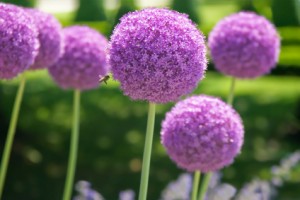Allium
The generic name of Allium is the Latin word for garlic and there are hundreds of distinct species. As quite a hardy flower, it is popular with gardeners as it grows quite well by itself, as long as it doesn’t become water-logged. Some species are even said to have medicinal properties and are often used in home remedies.
Description
Colours range from deep purples and blues to light pinks, whites and greens. Most Allium species have a distinctive shape round shape and are often described as looking like a firework frozen mid-explosion.
Habitat
Allium grows predominantly in the Northern Hemisphere, particularly Asia, but some species are known to grow in Africa, Chile and Brazil.
Availability
Most species will bloom between spring and September if planted in sunny areas. Make sure the ground is not too wet and, if you have poor soil, that it has been treated with nutrient-rich compost before planting.
Species
It is from the family Amaryllidaceae and the sub-family Allioideae. In some older classification systems it was described as Liliaceae instead.
Allium is a difficult flower to accurately quantify but most sources agree there are around 750 species. It is commonly known as the Ornamental Onion and most types have a faint onion or garlic scent.
Most bulb and petal varieties are edible although some species are poisonous to dogs and cats, so best to check before you plant them if you own pets.
Care Tips
It is best to plant allium bulbs in autumn and try to pick a sheltered but sunny spot. They also do well when planted in deep pots. Additionally, separate clumps of flowers once they have withered and re-plant so they will grow better the following year.
Did you know?
One type of Allium is well-known for being able to grow on Mount Everest, and is even named after the world’s tallest mountain.
Allium flowers are thought to represent unity, and so are sometimes given between married couples or long-time acquaintances.
A number of larvae species use the Allium as food, including the Cabbage moth larvae, Garden Dart moth larvae and Large Yellow Underwing moth larvae.



